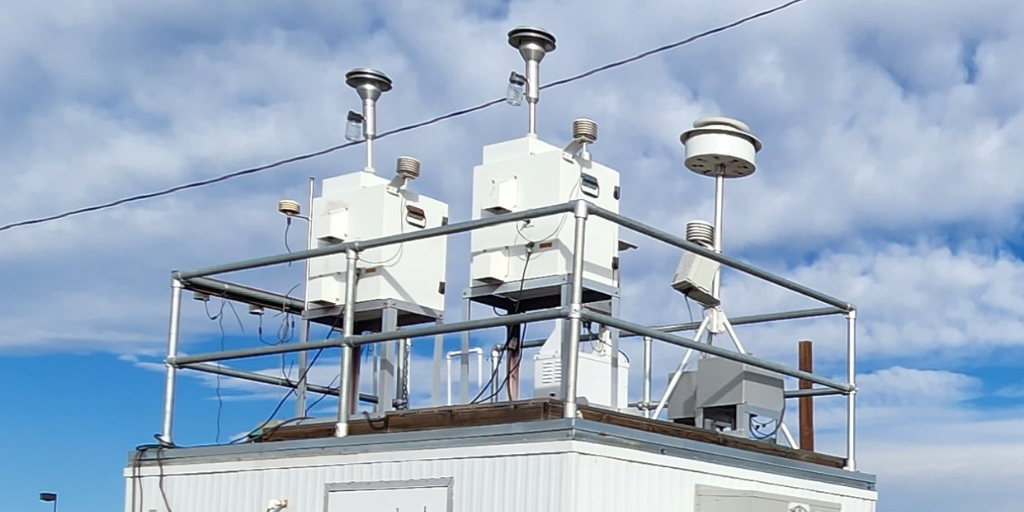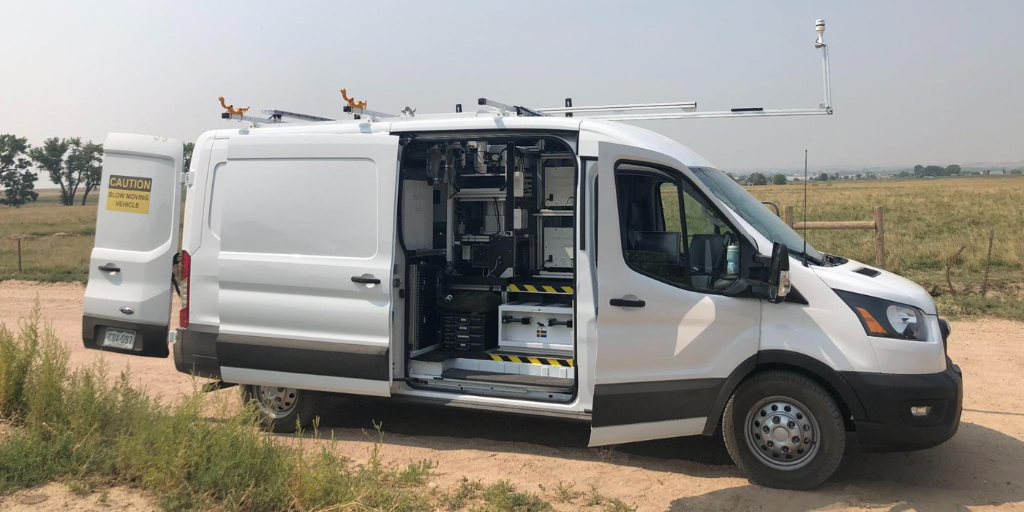Air toxics: Monitoring

Air toxics monitoring is a way to measure the amount of harmful pollutants in the air we breathe. Access to accurate and timely air toxics data is essential for protecting public health and the environment. These data help guide policy decisions and practices that promote a safer and healthier Colorado for all.
Air toxics information helps regulators work with communities, air pollution sources, and others to reduce air toxics emissions by:
- Developing or modifying rules and emissions standards.
- Implementing pollution control technologies.
- Improving production practices.
Additionally, monitoring air toxics can help inform public health responses, such as:
- Assessing exposures in communities near sources.
- Issuing health advisories and updates.
- Implementing emergency response plans during a hazardous release.
Types of air toxics monitoring strategies
Monitoring air pollutants is a complex and dynamic challenge. No single instrument can measure all pollutants, nor is there one monitoring strategy that can answer all air quality questions. As a result, both the specific monitoring strategy and type of instruments must be chosen carefully. Several key monitoring strategies are described below, along with the pros and cons of each.
Compliance monitoring
Compliance monitoring is vital for ensuring that air pollution sources, such as industrial facilities, operate within the limits set by environmental regulations and permits. This type of monitoring provides real-time data on the levels of pollutants released into the environment through direct monitoring of stacks, chimneys, or other pollution sources.
If a source is equipped with a control technology to capture or reduce emissions, then monitoring must occur after emissions pass through the emissions control device. This information helps operators quickly identify deviations from regulatory requirements or permit limits.
Compliance monitoring can also help identify any operational or maintenance issues contributing to elevated emissions, allowing for prompt corrective actions.
The instruments used in compliance monitoring include "continuous emission monitoring systems" (CEMS), “continuous parametric monitoring systems” (CPMS), and “predictive emission monitoring systems” (PEMS).
Objectives
- Evaluate whether an operational process is in compliance with regulations or permits.
- Evaluate whether control technologies are functioning properly on short time scales and/or rolling limits (such as 1-hour, 4-hour, 24-hour, 30-day).
Pros
- Provides actual emissions data directly from the point of emissions and individual pollution sources.
- Provides legally enforceable data.
Cons
- Limited to equipment/control technology where monitoring is located and does not include fugitive (or unintended) emissions; does not provide real time information on exposure in communities near sources.
Fenceline monitoring
Fenceline monitoring helps ensure the health and safety of communities living near air pollution sources, such as industrial facilities. By measuring pollutants around the perimeter of a facility, fenceline monitoring can provide an early warning of potential health hazards. This approach can be particularly important for protecting at-risk populations such as children, elderly people, and individuals with respiratory or other health conditions.
Fenceline monitoring can also help identify unintended releases of air pollution, known as “fugitive emissions,” from industrial facilities. Fugitive emissions can occur during routine operations or due to equipment malfunctions. Fenceline monitoring can detect these emissions at the source and help identify causes. Facility operators can then take corrective actions to reduce or eliminate the unintended emissions, improving air quality and reducing public health risks.
Objectives
- Monitor for pollutants not captured by a facility's emission control technologies, including unintended (“fugitive”) emissions.
Pros
- Fenceline monitoring is close to the source of air pollution (at the perimeter of the facility).
- Fenceline monitoring captures emissions not released through stacks, allowing facilities to rapidly identify potential errors, leaks, or malfunctions.
- Fenceline monitoring information allows air pollution sources to take action, potentially resulting in fewer pollutants emitted, reduced amount of pollution, and potentially less loss of product.
Cons
- Fenceline monitoring cannot identify the exact piece of equipment malfunctioning.
- Detection can depend on wind direction and other weather factors.
Stationary monitoring
Stationary monitoring is essential for measuring air pollution in a specific location over an extended time. Various instruments and methods can be used to make measurements at permanent or semi-permanent sites.
For instance, a regulatory air monitoring station collecting data over many years, is an example of a permanent site. A portable trailer stationed in a community to monitor continuously over several months would be considered a semi-permanent site.
Stationary monitoring data can provide information on air quality trends and the effectiveness of pollution control measures and rules. It is also important for measuring the impact of specific air pollution events, such as wildfires or windblown dust.
Additionally, stationary monitoring can provide baseline data needed for evaluating the impact of new industrial facilities or transportation projects on air quality.
Objectives
- Collect continuous data over months or years to provide information on trends and air quality events.
Pros
- Capture information on how air quality varies over time based on trends and air quality events, such as wildfires.
Cons
- Unless the stationary sites are part of a large or dense network of sites, there will be limited information on the “spatial variability” in air quality – meaning the variation of the air quality in different locations over time.
- Stationary sites depend on wind and dispersion to transport pollutants to the monitoring sites so the pollutants can be measured.
Mobile monitoring
Mobile monitoring is a flexible and effective tool for assessing air pollution in a variety of settings. By using vehicles outfitted with a variety of instruments that measure air quality, mobile monitoring can provide real-time data in areas that may not be covered by stationary air monitoring stations. This approach can be particularly valuable in urban areas, where pollution levels can vary widely from one street to the next.
Mobile monitoring can help identify pollution hot spots and track air pollution emission plumes. Moreover, mobile monitoring can be deployed relatively quickly in response to requests or for special projects.
Objectives
- Evaluate which air pollutants may be present in a community or around a facility.
- Help identify air pollution plumes, fugitive (unintended) leaks, or pollution hotspots.
Pros
- Mobile monitoring can cover large spatial areas and prioritize specific communities of interest, including disproportionately impacted communities that have more than their fair share of environmental exposure and may experience higher levels of environmental harm as a result.
- Mobile monitoring can capture “spatial variability” (differences in different locations) and “transient emissions” (short-term or brief spikes in pollutants) since the instruments used typically collect data with high time resolution.
- Mobile monitoring is less dependent on the wind compared to stationary monitoring.
Cons
- Mobile monitoring might not capture the temporal variability (changes over time) for air pollution in a single location.
- Mobile monitoring is resource-intensive. (The vehicles and resulting data are highly complex, requiring highly trained staff.)
- It can be challenging to relate resulting data to health guideline values, which are levels set by federal and state agencies to identify levels of pollutants that may cause health impacts.
- Mobile monitoring measurements cannot be definitively tied to a particular facility or specific source of air pollution.
Community air quality monitoring
Community air quality monitoring is a powerful tool for engaging people in monitoring and managing air pollution in their local neighborhoods. Providing locally-relevant information on air quality can help: raise awareness about what air pollution is, what pollutants are present, potential health risks associated with air pollution, and actions Coloradans can take to protect themselves and improve air quality. Actions people can take include personal behaviors and habits such as checking the air quality before going outside, participating in the development of local and state air pollution control measures, and choosing cleaner and more sustainable transportation options such as public transportation, electric cars, and electric trucks.
Community monitoring may leverage compliance, fenceline, stationary, or mobile air monitoring strategies, or employ a combination of them. A key aspect of community monitoring is active participation from local residents. For example, local community members might directly participate in steering committees or work with monitoring teams to collect data. By sharing their lived experiences and observations, communities may even help identify sources of pollution not detected by traditional methods, such as those driven by local traffic patterns. Involving communities in air monitoring can foster a collaborative approach to air quality management that bolsters trust, improves public health outcomes, and empowers Coloradans to protect their health and local environment.
Discover ways to get involved in upcoming public participation opportunities related to air quality and climate change.
Objectives
- Directly engage communities in locally relevant air pollution monitoring.
Pros
- Through direct feedback, communities help determine which pollutants to measure and where.
- Build trust between community members and government agencies (such as local, state, and federal public health agencies).
- Customize air pollution monitoring to address local needs and concerns.
- On-the-ground data collection at local sites can enhance understanding about air pollution challenges in particular communities.
- The combination of local feedback and data can inform strategies to reduce air pollution or people’s exposure to air pollutants.
Cons
- Projects can take longer at all stages. The number of stakeholders is larger and the process of collecting feedback and reaching consensus may be time consuming.
- Community goals and timelines must be determined up front for the monitoring to meet the community’s needs and it may be difficult to adjust goals based on findings or due to funding limitations.
- Many logistics to navigate across different individuals and organizations - such as setting up data-sharing agreements between government agencies or researchers and community groups.
- Potential challenges with longevity, such as securing long-term funding if a project is initially supported by a grant.


